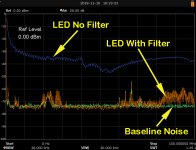Tonight I played with several different quick fixes to help eliminate the RFI from the trouble maker LED assm. Right off the bat a 0.15 uF cap across the power line did hardly anything. The same capacitor in parallel with a 100 pF & a 0.01 uF cap was just a hair better but still mostly useless.
All those caps in addition to a type 31 ferrite core with 5 turns started to make a dent but had a long way to go. Adding a type 43 core with 5 turns created the "water balloon effect". That is where some frequencies got a little better but other frequencies got a little worse. We call it that because you can imagine squeezing a water balloon in one spot to make it smaller but the balloon plumps out bigger someplace else.
It became obvious it was going to take a much more serious filtering approach. I quickly designed up a combination common-mode & differential filter using discrete capacitors and inductors and tried it out. The results looked promising enough to inspire me to refine the design and actually make the filter presentable. Below should be an image showing the spectral response of the LED with and w/o the prototype filter in addition to a baseline noise level.
The top (blue)trace is the LED w/o filter, the orange trace is the LED with filter, and the green trace is the noise baseline. That green trace shows ambient radio stations and other misc transmitters and other RF sources my loose wires were picking up. The plot basically shows that at low frequencies (like around the AM band) the LED RFI levels were reduced by about 55 dB (a factor of about 3 million times less power). Higher up in frequency near the CB band the levels were reduced about 30 dB (a factor of about 1000 times less power). Even higher up in frequency near the FM radio band the levels were reduced about 35 dB (a factor of about 3000 times less power). So I am thinking when I refine the filter these numbers will be even better.
View attachment 628834


